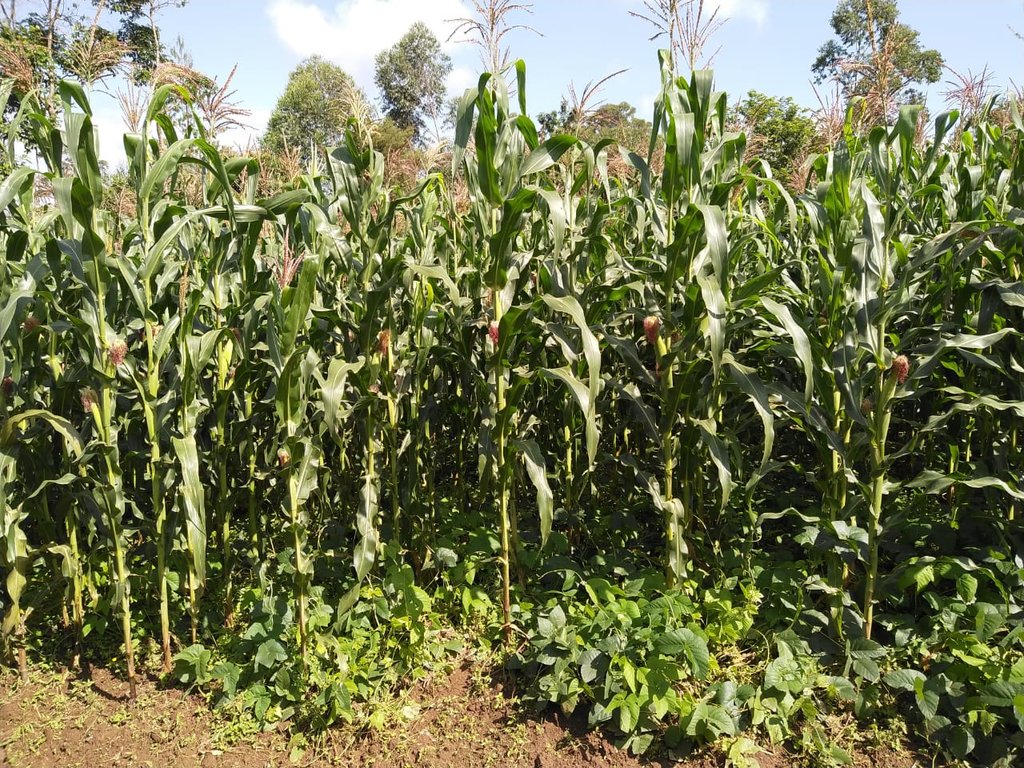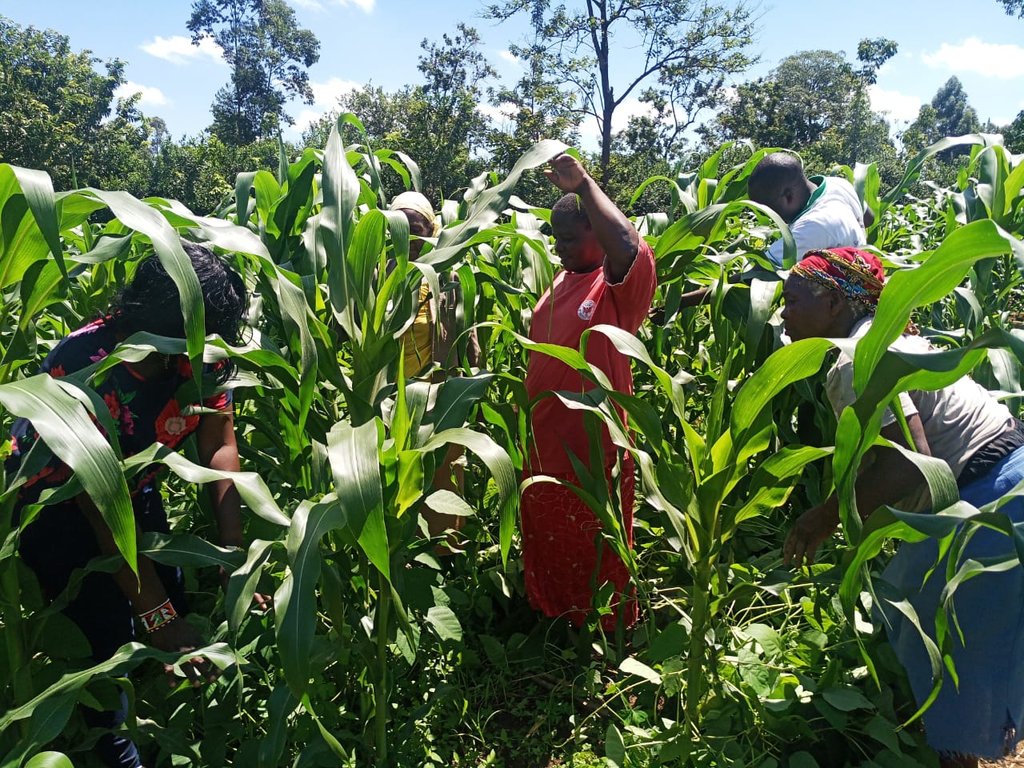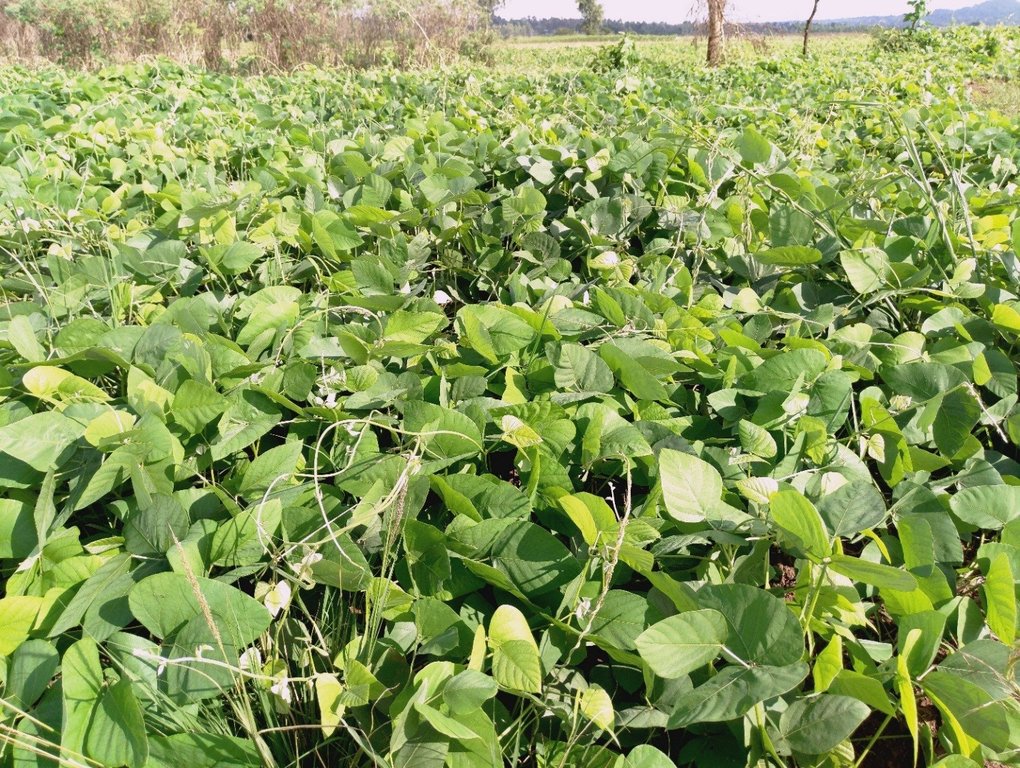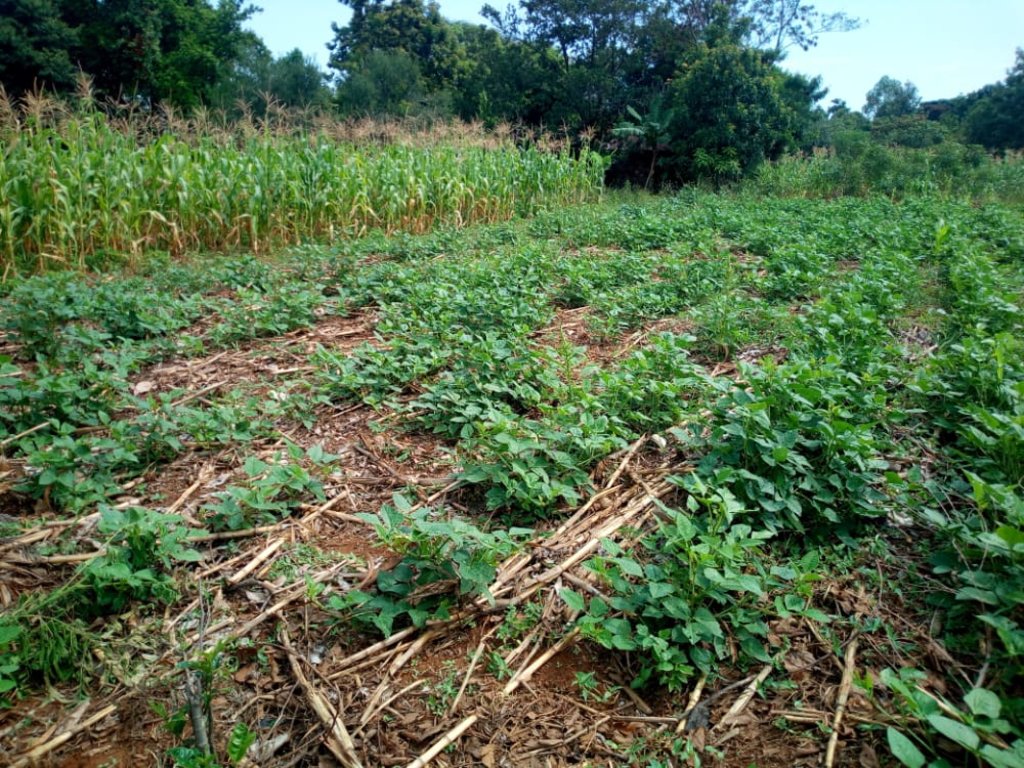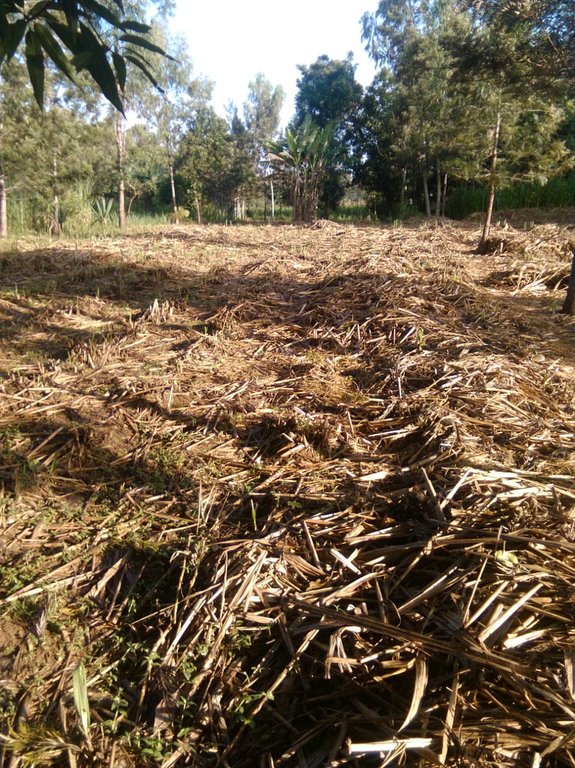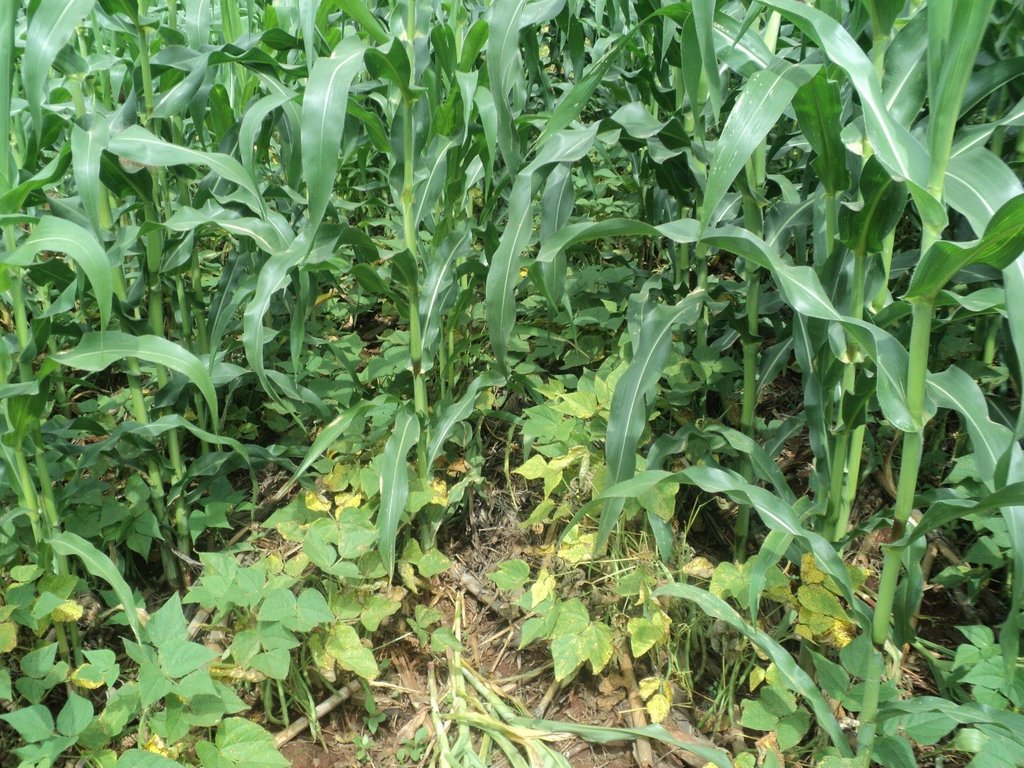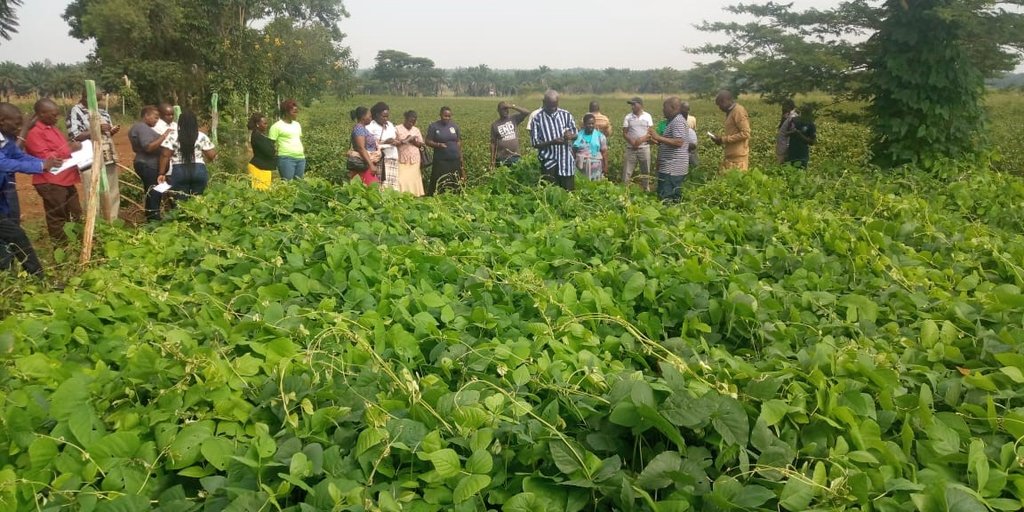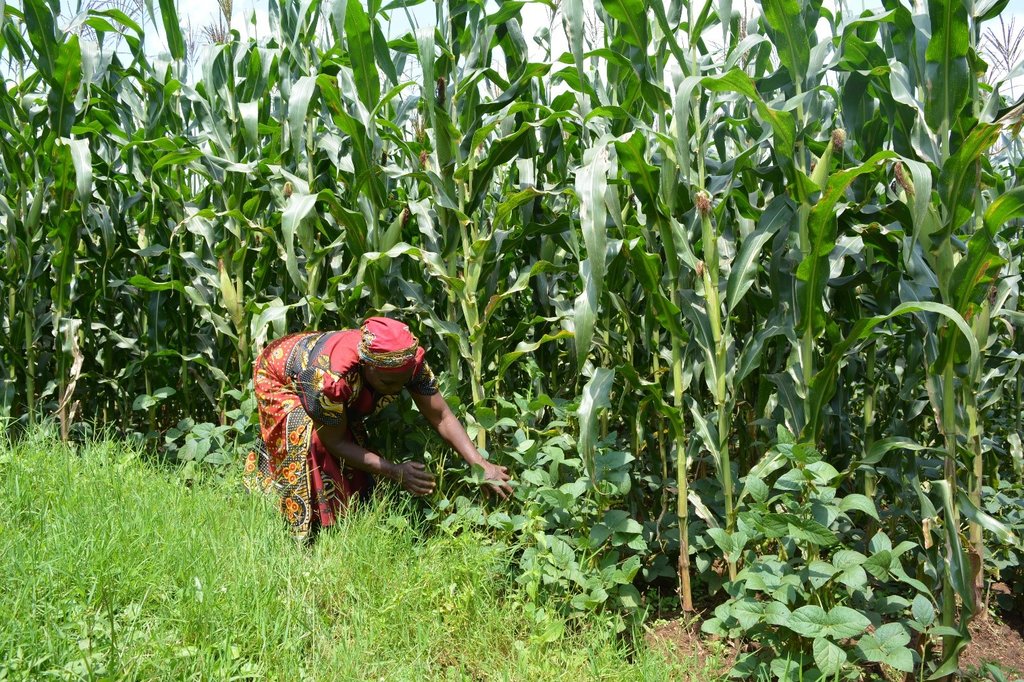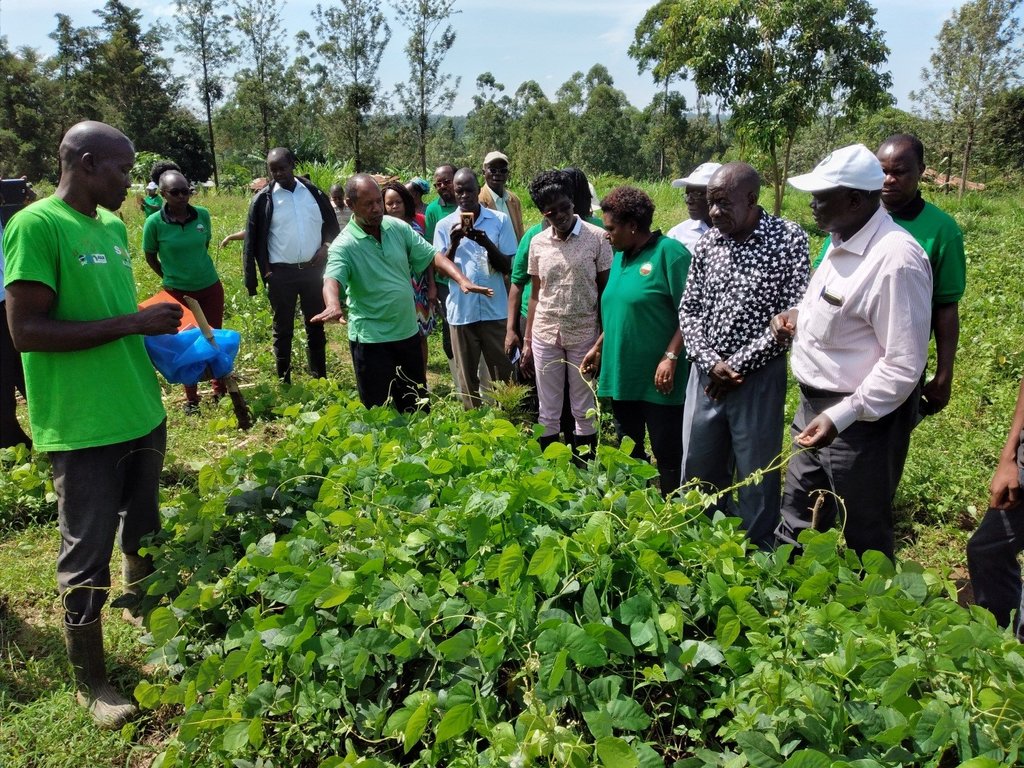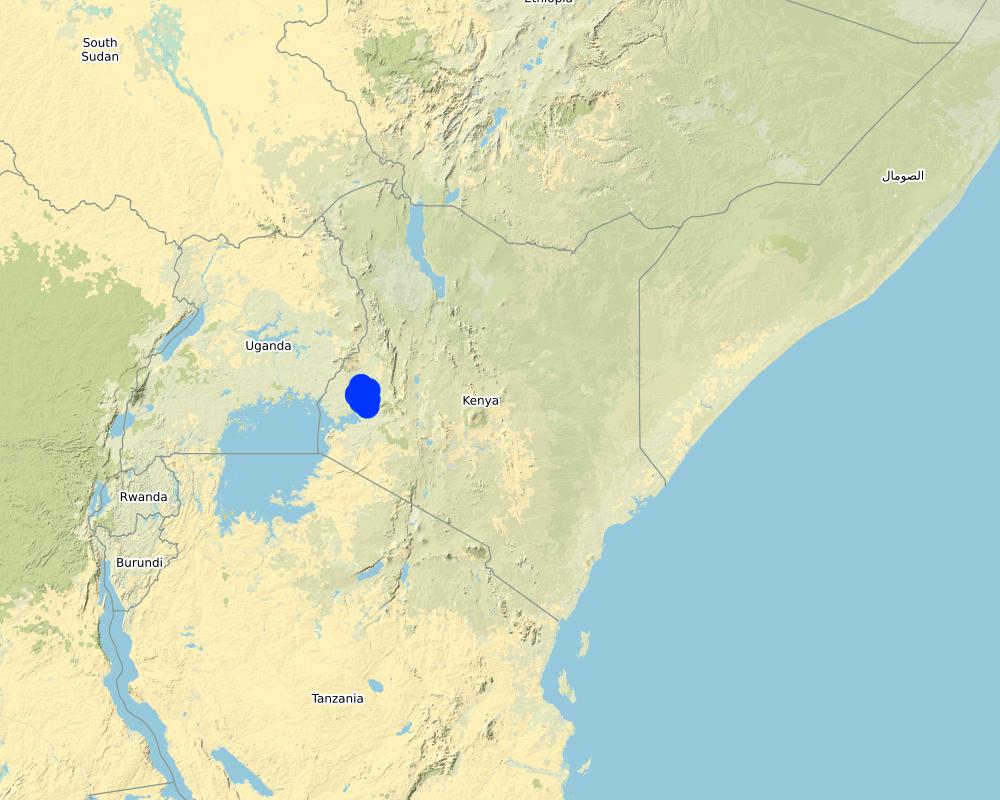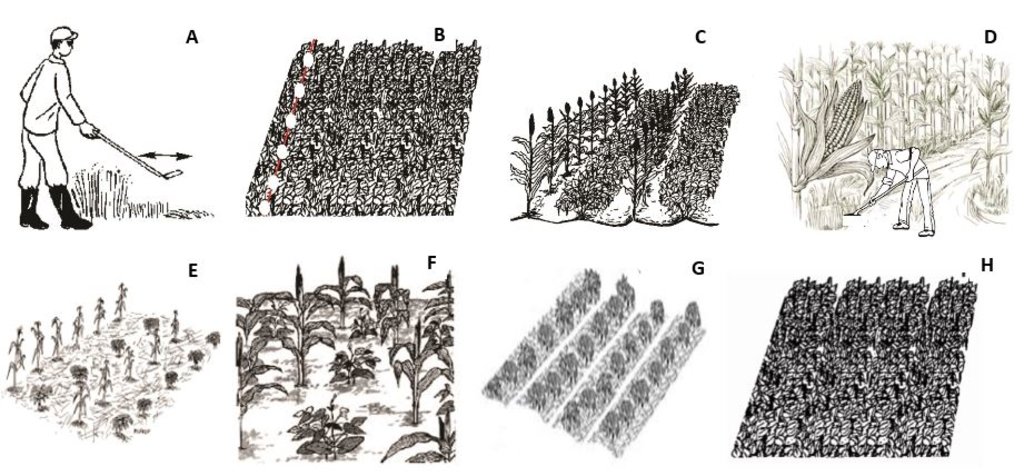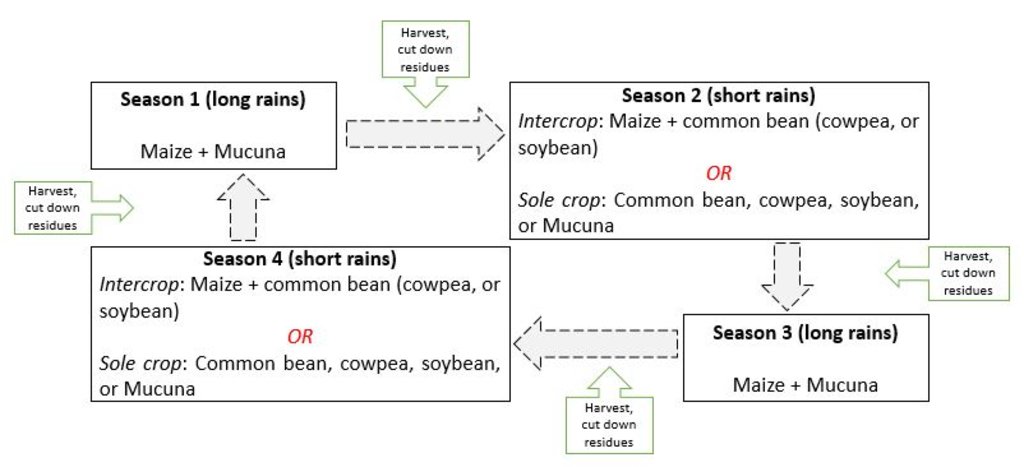Conservation agriculture for maize-legume systems with velvet bean as a dense cover crop [Quênia]
- Criação:
- Atualização:
- Compilador/a: Kennedy Were
- Editor: –
- Revisores: Rima Mekdaschi Studer, Tatenda Lemann
Kilimo hifadhi
technologies_5775 - Quênia
Veja as seções
Expandir tudo Recolher tudo1. Informação geral
1.2 Detalhes do contato das pessoas capacitadas e instituições envolvidas na avaliação e documentação da tecnologia
Especialista em GST:
Especialista em GST:
Especialista em GST:
Especialista em GST:
Nome do projeto que facilitou a documentação/avaliação da Tecnologia (se relevante)
GEF-UNEP-AGRA-KALRO SLM ProjectNome do projeto que facilitou a documentação/avaliação da Tecnologia (se relevante)
Carbon Benefits Project (CBP)Nome da(s) instituição(ões) que facilitou(ram) a documentação/ avaliação da Tecnologia (se relevante)
Kenya Agricultural and Livestock Research Organization (KALRO) - Quênia1.3 Condições em relação ao uso da informação documentada através de WOCAT
O/a compilador/a e a(s) pessoa(s) capacitada(s) aceitam as condições relativas ao uso de dados documentados através da WOCAT:
Sim
1.4 Declaração de sustentabilidade da tecnologia descrita
A tecnologia descrita aqui é problemática em relação a degradação da terra de forma que não pode ser declarada uma tecnologia de gestão sustentável de terra?
Não
2. Descrição da tecnologia de GST
2.1 Descrição curta da tecnologia
Definição da tecnologia:
Conservation agriculture for maize-legume systems with velvet bean (Mucuna pruriens) as a dense cover crop is being promoted in western Kenya to address the challenges of land degradation, low crop yields, low incomes, high production costs and climate change.
2.2 Descrição detalhada da tecnologia
Descrição:
Agriculture in western Kenya suffers from low productivity due to the degraded landscape. The soils are predominantly acidic and low in fertility, with the yields of food staples, such as maize and common bean averaging 1 ton/ ha and 5 tons/ ha, respectively. Consequently, the smallholder farmers have encroached into the adjacent Kakamega and Nandi forests in their quest for supplementary agro-ecosystem services and farm incomes. Degradation of the agro-resource base is underpinned by unsustainable practices carried out under conventional farming; for example, continuous cultivation with low nutrient inputs, mono-cropping, removal of crop residues and full tillage. Some of these practices enhance climate change by intensifying the emissions of greenhouse gases, such as carbon dioxide (CO2) into the atmosphere. Therefore, widespread adoption of conservation agriculture (CA) technology is being promoted to reduce the adverse impacts of conventional farming and enhance sustainable land management, environmental protection, and climate change mitigation and adaptation in 10 micro-catchments located within a 5-km radius from the edge of Kakamega and Nandi forests. The CA technology is characterized by the principles of minimum mechanical soil disturbance, maintenance of at least 30 percent permanent organic soil cover, diversified cropping through intercropping and crop rotations, and weed control. These principles have been adapted to the local conditions and needs.
The establishment of CA technology begins with land preparation. That is, the existing weeds and previous crop residues in the field are either slashed, or controlled through the application of appropriate herbicides. All the residues are retained on soil surface as opposed to burning, or removal in the conventional system. Land preparation is followed by planting, where the jab planter is used for precise placement of seeds and fertilizers in un-ploughed field, or within the established planting hills and rip lines to minimize soil tillage. This contrasts with conventional farming practice where a plough, or a hand hoe is used to till the entire field and establish the planting holes for placing seeds and fertilizers. A combination of cereal (maize – Zea mays L.) and legumes (common bean – Phaseolus vulgaris L., soybean - Glycine max, velvet bean – Mucuna pruriens and cowpea – Vigna unguiculata) are either intercropped, or rotated in the field each season to optimize the use of the available soil resources, including water, nutrients, and micro-organisms. The main cereal-legume association involves the establishment of Mucuna pruriens under maize as a dense cover crop. In this cropping system, Mucuna pruriens seeds are sown within a spacing of 1 m × 0.5 m where they grow and spread to completely cover the soil surface. As the cover crop grows, the leaves fall and decompose on the ground, enriching the soil’s nutrients, organic matter and fertility. The maize - Mucuna pruriens mix is rotated with either sole common bean, soybean and cowpea crop, or an intercrop of maize with any of the legumes. Weeding is carried out using either selective herbicides, or weed scrapers. When designing the intercropping and rotation plans, crop families (N-fixing vs. non-fixing), root depths (shallow vs. deep roots), and susceptibility to diseases, pests and weeds are all considered.
Generally, CA technologies have multiple benefits for farmers and the environment. In the context of the Kakamega-Nandi forest landscape, the CA plots with Mucuna pruriens as a dense cover crop have shown improved soil organic matter, soil structure and nutrient status. It is expected that this will reduce the use of fertilizers over time. Most farmers have also reported that reduced tillage and direct placement of inputs (seeds and fertilizers) save them time, money, fuel, labour and inputs. Aside from saving resources, reduced tillage will ultimately enhance soil living organisms and mitigate atmospheric CO2 emissions through the decrease in fuel consumption and soil disturbance. Moreover, farmers have observed that the maize established with Mucuna pruriens as a cover crop remains green and healthy for long during mid-season dry spells compared to those under mono-culture, or light mulch. This implies that the CA technology also increases water infiltration and soil water content; thus, acting as insurance against drought. The increase in water infiltration and soil moisture occurs because the dense Mucuna pruriens cover crop not only regulates the soil surface temperatures and evaporation, but also reduces surface runoff and exposure to wind erosion. In addition, farmers have witnessed the suppression of weeds, such as Striga hermonthica (witchweed) in plots under dense cover crop and diversified cropping. Besides, diversified cropping through rotations has reduced the incidences of insect pests and diseases, as well as the risk of crop failure during extreme weather conditions and pest infestations. Specifically, farmers have noticed that the CA plots under maize - Mucuna pruriens intercrop are less affected by the fall armyworm (Spodoptera frugiperda) compared to those under mono-culture. They have also noted that, in seasons of excessive rainfall, the maize intercropped with the common bean is usually harvested even when the common bean fails. Most importantly, these CA benefits have boosted maize yields by over 50 percent, meaning more food and income, and fewer forest encroachments.
Proper adoption of the CA technology by land users within the Kakamega-Nandi forest landscape is being hampered by several factors. Firstly, crop residues are inadequate due to competing uses, such as animal feed and fuel. At times, livestock is even allowed to graze on the stubble field, contravening the CA principles. Besides, some farmers have not fully embraced crop diversification and still grow maize throughout the seasons without rotation with other drought-tolerant cereals, such as sorghum and millet. Conventional ploughing is also quite entrenched. Further, some farmers still do not prefer Mucuna pruriens as a cover crop because of insufficient knowledge on the utilization of its inedible yields. Lastly, some farmers are finding it hard to access CA inputs and tools, such as the jab planters, weed scrapers, herbicides and seeds of Mucuna pruriens owing to either high prices, or shortages.
2.3 Fotos da tecnologia
2.4 Vídeos da tecnologia
2.5 País/região/locais onde a tecnologia foi aplicada e que estão cobertos nesta avaliação
País:
Quênia
Região/Estado/Província:
Western region
Especificação adicional de localização:
Kakamega-Nandi forest landscape
Especifique a difusão da tecnologia:
- Aplicado em pontos específicos/concentrado numa pequena área
O(s) local(is) tecnológico(s) está(ão) localizado(s) em uma área permanentemente protegida?
Não
Map
×2.6 Data da implementação
Indique o ano de implementação:
2019
2.7 Introdução da tecnologia
Especifique como a tecnologia foi introduzida:
- durante experiências/ pesquisa
- através de projetos/intervenções externas
Comentários (tipos de projeto, etc.):
Projects and research focusing mainly on advancing land degradation neutrality and agricultural productivity in the area
3. Classificação da tecnologia de GST
3.1 Principal/principais finalidade(s) da tecnologia
- Melhora a produção
- Reduz, previne, recupera a degradação do solo
- Preservar/melhorar a biodiversidade
- Atenuar a mudanças climáticas e seus impactos
- Criar impacto econômico benéfico
3.2 Tipo(s) atualizado(s) de uso da terra onde a tecnologia foi aplicada
Uso do solo misturado dentro da mesma unidade de terra:
Sim
Especificar o uso misto da terra (culturas/ pastoreio/ árvores):
- Agropecuária (incl. agricultura e pecuária)

Terra de cultivo
- Cultura anual
Cultivo anual - Especificar culturas:
- cereais - milho
- Legumes e leguminosas - feijão
- legumes e leguminosas - ervilhas
- legumes e leguminosas - soja
Sistema de cultivo anual:
Milho/sorgo/painço entremeado com legumes
Número de estações de cultivo por ano:
- 2
Especifique:
Long rain season (March to May) and short rain season (October to December)
O cultivo entre culturas é praticado?
Sim
Em caso afirmativo, especifique quais são as culturas intercultivadas:
Maize and legumes (i.e., common bean, soybean and velvet bean – Mucuna pruriens)
O rodízio de culturas é praticado?
Sim
Caso afirmativo, especifique:
Maize and legumes (i.e., common bean, soybean and velvet bean – Mucuna pruriens)

Pastagem
Pastagem intensiva/produção de forragem:
- Semiestabulação/sem pastagem
- Pastos melhorados
Tipo de animal:
- gado - leite e carne bovina (por exemplo, zebu)
É praticado o manejo integrado de culturas e pecuária?
Sim
Caso afirmativo, especifique:
Manure is used for fertilization and crop residues are used as cattle feed
Produtos e serviços:
- estrume como fertilizante/ produção de energia
- carne
- leite
- peles/couros
- transporte/calado
3.3 O uso do solo mudou devido à implementação da Tecnologia?
O uso do solo mudou devido à implementação da Tecnologia?
- Sim (Por favor, preencha as perguntas abaixo com relação ao uso do solo antes da implementação da Tecnologia)
Uso do solo misturado dentro da mesma unidade de terra:
Sim
Especificar o uso misto da terra (culturas/ pastoreio/ árvores):
- Agropecuária (incl. agricultura e pecuária)

Terra de cultivo
- Cultura anual
Cultivo anual - Especificar culturas:
- cereais - milho
Sistema de cultivo anual:
Milho/sorgo/painço contínuo
O cultivo entre culturas é praticado?
Não
O rodízio de culturas é praticado?
Não

Pastagem
Pastagem intensiva/produção de forragem:
- Semiestabulação/sem pastagem
Tipo de animal:
- gado - leite e carne bovina (por exemplo, zebu)
É praticado o manejo integrado de culturas e pecuária?
Sim
Caso afirmativo, especifique:
Manure is used for fertilization and crop residues are used as cattle feed
Produtos e serviços:
- estrume como fertilizante/ produção de energia
- carne
- leite
- peles/couros
- transporte/calado
3.4 Abastecimento de água
Abastecimento de água para a terra na qual a tecnologia é aplicada:
- Precipitação natural
3.5 Grupo de GST ao qual pertence a tecnologia
- Solo/cobertura vegetal melhorada
- Perturbação mínima ao solo
- Gestão integrada de fertilidade do solo
3.6 Medidas de GST contendo a tecnologia

Medidas agronômicas
- A1: cobertura vegetal/do solo
- A2: Matéria orgânica/fertilidade do solo
- A3: Tratamento da superfície do solo
- A6: Gerenciamento de resíduos
A3: Diferenciar os sistemas de lavoura:
A 3.2: Reduced tillage (> 30% soil cover)
A6: Especificar o gerenciamento de resíduos:
A 6.4: retido
3.7 Principais tipos de degradação da terra abordados pela tecnologia

Erosão do solo pela água
- Wt: Perda do solo superficial/erosão de superfície

Erosão do solo pelo vento
- Et: Perda do solo superficial

Deteriorização química do solo
- Cn: declínio de fertilidade e teor reduzido de matéria orgânica (não causado pela erosão)

Deteriorização física do solo
- Pc: Compactação

Degradação biológica
- Bl: perda da vida do solo

Degradação da água
- Ha: aridificação
3.8 Redução, prevenção ou recuperação da degradação do solo
Especifique o objetivo da tecnologia em relação a degradação da terra:
- Reduzir a degradação do solo
4. Especificações técnicas, implementação de atividades, entradas e custos
4.1 Desenho técnico da tecnologia
Especificações técnicas (relacionada ao desenho técnico):
The first technical drawing shows a typical farm under CA with various principles:
A - Clearance of weeds and previous crop residues through slashing in preparation for planting in season 1 (long rains). The residues are retained on the plot.
B - In a plot under total soil cover with Mucuna pruriens, maize seed and fertilizer are placed at the precise planting hills, denoted by the white circles along the red line, using a jab planter to minimize soil tillage.
C - Maize crop establishes under the dense cover of Mucuna pruriens.
D - Weeding of the maize crop is done using a weed scraper.
E & F - In season 2 (short rains), after harvesting maize in the previous maize – Mucuna cropping system and cutting down the residues, either a row intercropping system with alternate rows of maize and soybean (E), or maize and common bean (F) under maize straw mulch is established.
G & H - Alternatively, in season 2 (short rains), either sole common bean (cowpea, or soybean) production under maize straw mulch (G), or total soil cover with Mucuna pruriens (H) is established in the plot.
Autor:
Sam Koile, Kennedy Were & George Ayaga
Data:
31/05/2020
Especificações técnicas (relacionada ao desenho técnico):
The second technical drawing is an illustration of a four season (2-year) rotation of maize, legumes and cover crop
Autor:
Kennedy Were, Sam Koile & George Ayaga
Data:
15/07/2020
4.2 Informação geral em relação ao cálculo de entradas e custos
Especifique como custos e entradas foram calculados:
- por área de tecnologia
Indique o tamanho e a unidade de área:
1 ha
Se utilizar uma unidade de área local, indicar fator de conversão para um hectare (por exemplo, 1 ha = 2,47 acres): 1 ha =:
2.47 acres
Outro/moeda nacional (especifique):
KES
Se for relevante, indique a taxa de câmbio do USD para moeda local (por exemplo, 1 USD = 79,9 Real): 1 USD =:
107,08
Indique a média salarial da mão-de-obra contratada por dia:
300
4.3 Atividades de implantação
| Atividade | Periodicidade (estação do ano) | |
|---|---|---|
| 1. | Purchase of CA tools - jab planter, knapsack sprayer, protection gear, slasher, weed scraper, and gunny bag) | Initial stage |
4.4 Custos e entradas necessárias para a implantação
| Especifique a entrada | Unidade | Quantidade | Custos por unidade | Custos totais por entrada | % dos custos arcados pelos usuários da terra | |
|---|---|---|---|---|---|---|
| Equipamento | Jab planter | Piece | 2,0 | 1500,0 | 3000,0 | 100,0 |
| Equipamento | Knapsack sprayer | Piece | 2,0 | 2500,0 | 5000,0 | 100,0 |
| Equipamento | Protection gear | Piece | 2,0 | 1000,0 | 2000,0 | 100,0 |
| Equipamento | Weed scraper | Piece | 2,0 | 500,0 | 1000,0 | 100,0 |
| Equipamento | Slasher | Piece | 2,0 | 500,0 | 1000,0 | 100,0 |
| Equipamento | Gunny bag | Piece | 50,0 | 50,0 | 2500,0 | 100,0 |
| Custos totais para a implantação da tecnologia | 14500,0 | |||||
| Custos totais para o estabelecimento da Tecnologia em USD | 135,41 | |||||
4.5 Atividades recorrentes/manutenção
| Atividade | Periodicidade/frequência | |
|---|---|---|
| 1. | Land preparation - Slashing | Initial stage |
| 2. | Preparing the planting hills and rip lines | Initial stage |
| 3. | Planting - placing seeds and fertilizer using jab planter | Initial stage |
| 4. | Herbicide application | Initial and growing stages |
| 5. | Pesticide application | Growing stage |
| 6. | Fertilizer application (top-dressing) | Growing stage |
| 7. | Harvesting, drying and shelling | Final stage |
4.6 Custos e entradas necessárias pata a manutenção/atividades recorrentes (por ano)
| Especifique a entrada | Unidade | Quantidade | Custos por unidade | Custos totais por entrada | % dos custos arcados pelos usuários da terra | |
|---|---|---|---|---|---|---|
| Mão-de-obra | Land preparation - slashing and herbicide application | Man day | 4,0 | 300,0 | 1200,0 | 100,0 |
| Mão-de-obra | Planting - preparing the planting hills and placing seeds and fertilizer | Man day | 38,0 | 300,0 | 11400,0 | 100,0 |
| Mão-de-obra | Top-dressing and pesticide application | Man day | 8,0 | 300,0 | 2400,0 | 100,0 |
| Mão-de-obra | Harvesting, shelling and drying | Man day | 30,0 | 300,0 | 9000,0 | 100,0 |
| Material vegetal | Maize seed | Kg | 20,0 | 250,0 | 5000,0 | 100,0 |
| Material vegetal | Legume seed | Kg | 8,0 | 250,0 | 2000,0 | 100,0 |
| Fertilizantes e biocidas | Planting fertilizer | Kg | 125,0 | 60,0 | 7500,0 | 100,0 |
| Fertilizantes e biocidas | Top-dressing fertilizer | Kg | 125,0 | 50,0 | 6250,0 | 100,0 |
| Fertilizantes e biocidas | Pesticide | Litre | 2,0 | 1250,0 | 2500,0 | 100,0 |
| Fertilizantes e biocidas | Herbicide | Litre | 5,0 | 875,0 | 4375,0 | 100,0 |
| Outros | Transport | Km | 5,0 | 1500,0 | 7500,0 | 100,0 |
| Custos totais para a manutenção da tecnologia | 59125,0 | |||||
| Custos totais de manutenção da Tecnologia em USD | 552,16 | |||||
4.7 Fatores mais importantes que afetam os custos
Descreva os fatores mais determinantes que afetam os custos:
1. Prevailing market prices of the inputs, equipment and labour.
5. Ambiente natural e humano
5.1 Clima
Precipitação pluviométrica anual
- <250 mm
- 251-500 mm
- 501-750 mm
- 751-1.000 mm
- 1.001-1.500 mm
- 1.501-2.000 mm
- 2.001-3.000 mm
- 3.001-4.000 mm
- > 4.000 mm
Especificações/comentários sobre a pluviosidade:
Rainfall is bi-modal with the long rain season starting from March to May, and the short rains from October to December.
Zona agroclimática
- úmido
- Subúmido
mean annual temperature varies from 18 to 29° C
5.2 Topografia
Declividade média:
- Plano (0-2%)
- Suave ondulado (3-5%)
- Ondulado (6-10%)
- Moderadamente ondulado (11-15%)
- Forte ondulado (16-30%)
- Montanhoso (31-60%)
- Escarpado (>60%)
Formas de relevo:
- Planalto/planície
- Cumes
- Encosta de serra
- Encosta de morro
- Sopés
- Fundos de vale
Zona de altitude:
- 0-100 m s.n.m.
- 101-500 m s.n.m.
- 501-1.000 m s.n.m.
- 1.001-1.500 m s.n.m.
- 1.501-2.000 m s.n.m.
- 2.001-2.500 m s.n.m.
- 2.501-3.000 m s.n.m.
- 3.001-4.000 m s.n.m.
- > 4.000 m s.n.m.
Indique se a tecnologia é aplicada especificamente em:
- Não relevante
5.3 Solos
Profundidade do solo em média:
- Muito raso (0-20 cm)
- Raso (21-50 cm)
- Moderadamente profundo (51-80 cm)
- Profundo (81-120 cm)
- Muito profundo (>120 cm)
Textura do solo (solo superficial):
- Médio (limoso, siltoso)
- Fino/pesado (argila)
Textura do solo (>20 cm abaixo da superfície):
- Médio (limoso, siltoso)
- Fino/pesado (argila)
Matéria orgânica do solo superficial:
- Médio (1-3%)
- Baixo (<1%)
5.4 Disponibilidade e qualidade de água
Lençol freático:
5-50 m
Disponibilidade de água de superfície:
Médio
Qualidade da água (não tratada):
Água potável precária (tratamento necessário)
A qualidade da água refere-se a:
tanto de águas subterrâneas quanto de superfície
A salinidade da água é um problema?
Não
Ocorre inundação da área?
Não
5.5 Biodiversidade
Diversidade de espécies:
- Médio
Diversidade de habitat:
- Médio
5.6 Características dos usuários da terra que utilizam a tecnologia
Sedentário ou nômade:
- Sedentário
Orientação de mercado do sistema de produção:
- Subsistência (autoabastecimento)
- misto (subsistência/comercial)
Rendimento não agrícola:
- Menos de 10% de toda renda
- 10-50% de toda renda
Nível relativo de riqueza:
- Pobre
- Média
Indivíduos ou grupos:
- Indivíduo/unidade familiar
Nível de mecanização:
- Trabalho manual
- Tração animal
Gênero:
- Mulheres
- Homens
Idade dos usuários da terra:
- meia-idade
- idosos
5.7 Área média de terrenos utilizados pelos usuários de terrenos que aplicam a Tecnologia
- < 0,5 ha
- 0,5-1 ha
- 1-2 ha
- 2-5 ha
- 5-15 ha
- 15-50 ha
- 50-100 ha
- 100-500 ha
- 500-1.000 ha
- 1.000-10.000 ha
- > 10.000 ha
É considerado pequena, média ou grande escala (referente ao contexto local)?
- Pequena escala
5.8 Propriedade de terra, direitos de uso da terra e de uso da água
Propriedade da terra:
- Indivíduo, não intitulado
- Indivíduo, intitulado
Direitos do uso da terra:
- Indivíduo
Direitos do uso da água:
- Comunitário (organizado)
- Indivíduo
Os direitos de uso da terra são baseados em um sistema jurídico tradicional?
Sim
5.9 Acesso a serviços e infraestrutura
Saúde:
- Pobre
- Moderado
- Bom
Educação:
- Pobre
- Moderado
- Bom
Assistência técnica:
- Pobre
- Moderado
- Bom
Emprego (p. ex. não agrícola):
- Pobre
- Moderado
- Bom
Mercados:
- Pobre
- Moderado
- Bom
Energia:
- Pobre
- Moderado
- Bom
Vias e transporte:
- Pobre
- Moderado
- Bom
Água potável e saneamento:
- Pobre
- Moderado
- Bom
Serviços financeiros:
- Pobre
- Moderado
- Bom
6. Impactos e declarações finais
6.1 Impactos no local mostrados pela tecnologia
Impactos socioeconômicos
Produção
Produção agrícola
Quantidade anterior à GST:
24 bags/ ha
Quantidade posterior à GST:
43 bags/ ha
Comentários/especificar:
This can be attributed to the multiple benefits of the CA technology, such as improved soil organic matter content and nutrient status. Note: A standard bag weighs 90 kgs.
Qualidade da safra
Comentários/especificar:
The multiple benefits of the CA technology, such as improved soil conditions and alleviation of pests and diseases, not only increased crop production (yields), but also the quality of the crops.
Produção de forragens
Comentários/especificar:
Increased crop production also means increased fodder production because the crop residues are partly used as animal feed
Qualidade da forragem
Comentários/especificar:
Increased crop quality also implies increased fodder quality because the crop residues are partly used as animal feed
Risco de falha de produção
Comentários/especificar:
Specifically,
- the maize established with Mucuna pruriens as a cover crop have remained green and healthy for long during mid-season dry spells. The CA technology increases water infiltration and soil moisture because the dense cover crop not only regulates the soil surface temperatures and evaporation, but also reduces surface runoff
- the CA plots under maize - Mucuna pruriens inter-crop have been less affected by the fall armyworm (Spodoptera frugiperda).
- in seasons of excessive rainfall, the maize intercropped with the common bean has been harvested even when the common bean fails.
Diversidade de produtos
Comentários/especificar:
Farmers not only grow maize, but also mix or rotate it with common bean, soybean and cowpea
Gestão de terra
Comentários/especificar:
Operations such as precise and direct placement of inputs and minimum tillage have simplified land management
Renda e custos
Despesas com insumos agrícolas
Comentários/especificar:
Expenses on inputs, such as herbicides and fertilizers increased marginally, because the conventional farming practice had been characterized by low inputs; however, with improved soil organic matter, soil structure and nutrient status, as well as reduced incidences of pest, diseases and weeds, it is expected that the use of these inputs will diminish over time
Rendimento agrícola
Comentários/especificar:
Increased crop production means, more surplus and incomes
Diversidade de fontes de rendimento
Comentários/especificar:
Diversified cropping enables the farmers to get income from maize, common bean, soybean and cowpea production
Carga de trabalho
Comentários/especificar:
Reduced tillage has subsequently decreased the farmers' workload because they no longer have to plough the entire field
Impactos socioculturais
Segurança alimentar/auto-suficiência
Comentários/especificar:
Increased crop production means more food and less hungry periods. The legumes also provide a good source of protein to the farmers' households
Instituições comunitárias
Comentários/especificar:
The common interest groups have been greatly involved in the selection of the CA technologies. The strengthening of the community institutions has been done for sustainability and to allow sensitization of the technology to the wider population in the landscape. Some of thaccess by the communities. e promotion approaches have been on-farm demonstrations and training of trainers (ToTs), which have involved and empowered different farmer groups within the communities. Seed producers have also been trained to multiply seeds of specific crops, such as Mucuna pruriens for ease of access
Conhecimento de GST/ degradação da terra
Comentários/especificar:
On-farm demonstrations of the CA technology and the training of trainers (ToTs) have empowered different stakeholders within the communities with sufficient SLM/ land degradation knowledge
Impactos ecológicos
Ciclo hídrico/escoamento
Escoamento superficial
Comentários/especificar:
The dense Mucuna pruriens cover crop reduces surface runoff
Lençol freático/aquífero
Comentários/especificar:
There has been increase in water infiltration and soil water content because the dense Mucuna pruriens cover crop not only regulates the soil surface temperatures and evaporation, but also reduces surface runoff. This recharges the aquifer
Evaporação
Comentários/especificar:
The dense Mucuna pruriens cover crop regulates both the soil surface temperatures and evaporation
Solo
Umidade do solo
Comentários/especificar:
The increase in soil water content occurs because the dense Mucuna pruriens cover crop not only regulates the soil surface temperatures and evaporation, but also reduces surface runoff
Cobertura do solo
Comentários/especificar:
The dense Mucuna pruriens completely covers the soil surface, and is left on the ground even after the harvesting of maize
Perda de solo
Comentários/especificar:
The dense Mucuna pruriens cover crop reduces surface runoff and exposure to wind erosion
Acumulação de solo
Comentários/especificar:
Accumulation of soil organic carbon has occurred because the dense cover crop has a higher net primary productivity and sheds more leaves on the ground, resulting in more inputs of detritus to the soil. Similarly, retention of the large amount of crop residues especially those obtained from the leguminous crops has increased the inputs of carbon and nitrogen to the soil.
Ressecamento/ selagem do solo
Comentários/especificar:
The cover crop, minimum tillage and crop residues have protected the soil from the impact of raindrops, improved the surface soil structure and aggregate stability by increasing the organic matter content in the soil and stimulated soil biological activity, making the soil resistant to crusting
Compactação do solo
Comentários/especificar:
Reduced tillage or zero tillage has minimized farm land activities, e.g, ploughing which often result in compaction of soil. Incorporation of deep rooted crops with shallow rooted crops has also helped to break the various soil layers, thus hindering compaction. In addition, accumulation of soil organic carbon has improved soil biological activities that help to reduce soil compaction, through continuous burrowing.
Ciclo e recarga de nutrientes
Comentários/especificar:
As the dense cover crop grows, the leaves fall and decompose on the ground, enriching the soils with nitrogen and organic matter
Matéria orgânica do solo/carbono abaixo do solo
Comentários/especificar:
As the dense cover crop grows, the leaves fall and decompose on the ground, with organic matter additions.
Biodiversidade: vegetação, animais
Biomassa/carbono acima do solo
Comentários/especificar:
The dense cover crop has higher net primary productivity/ above-ground biomass C, which is left when the maize crop is harvested.
Diversidade vegetal
Comentários/especificar:
Farmers grow a mix of crops under the diverse cropping principle, which has increased plant diversity
Espécies exóticas invasoras
Comentários/especificar:
Farmers have witnessed the suppression of weeds, such as Striga hermonthica (witchweed) in plots under dense cover crop and diversified cropping.
Espécies benéficas
Comentários/especificar:
Reduced tillage and accumulation of soil organic carbon have increased beneficial soil living organisms, such as the earthworms.
Controle de praga/doença
Comentários/especificar:
Diversified cropping through rotations has reduced the incidences of insect pests and diseases through disruption of pest and disease cycles. Specifically, farmers have noticed that the CA plots under maize - Mucuna pruriens intercrop are less affected by the fall armyworm (Spodoptera frugiperda)
Clima e redução de riscos de desastre
Impactos da seca
Comentários/especificar:
The maize established with Mucuna pruriens as a cover crop has remained green and healthy for long during mid-season dry spells. This implies that the CA technology also increases water infiltration and soil water content; thus, acting as insurance against drought.
Emissão de carbono e gases de efeito estufa
Comentários/especificar:
Reduced tillage mitigates atmospheric carbon dioxide emissions through the decrease in fossil fuel consumption and soil disturbance. Crop residues are also retained in the field and not burnt; hence, reducing emission of carbon.
6.2 Impactos externos mostrados pela tecnologia
Impacto dos gases de efeito estufa
6.3 Exposição e sensibilidade da tecnologia às mudanças climáticas graduais e extremos/desastres relacionados ao clima (conforme o ponto de vista dos usuários da terra)
Mudança climática gradual
Mudança climática gradual
| Estação do ano | aumento ou diminuição | Como a tecnologia lida com isso? | |
|---|---|---|---|
| Temperatura anual | aumento | bem | |
| Precipitação pluviométrica anual | aumento | bem |
Extremos (desastres) relacionados ao clima
Desastres climatológicos
| Como a tecnologia lida com isso? | |
|---|---|
| Seca | bem |
Desastres biológicos
| Como a tecnologia lida com isso? | |
|---|---|
| Doenças epidêmicas | bem |
| Infestação de insetos/vermes | bem |
6.4 Análise do custo-benefício
Como os benefícios se comparam aos custos de implantação (do ponto de vista dos usuários da terra)?
Retornos a curto prazo:
levemente positivo
Retornos a longo prazo:
positivo
Como os benefícios se comparam aos custos recorrentes/de manutenção(do ponto de vista dos usuários da terra)?
Retornos a curto prazo:
levemente positivo
Retornos a longo prazo:
positivo
Comentários:
For example, it is expected that the associated improvement in soil organic matter, soil structure and nutrient status will reduce the use of fertilizers in the long term.
6.5 Adoção da tecnologia
- 1-10%
De todos aqueles que adotaram a Tecnologia, quantos o fizeram espontaneamente, ou seja, sem receber nenhum incentivo/ pagamento material?
- 51-90%
6.6 Adaptação
A tecnologia foi recentemente modificada para adaptar-se as condições variáveis?
Não
6.7 Pontos fortes/vantagens/oportunidades da tecnologia
| Pontos fortes/vantagens/oportunidades na visão do usuário da terra |
|---|
| Maize established with Mucuna pruriens as a dense cover crop is not adversely affected by the fall army worm (Spodoptera frugiperda) |
| Reduced tillage saves time, money and energy, while the direct placement of inputs (seeds and fertilizers) minimizes wastage. The saved resources can be used to engage in other income-generating activities |
| Maize established with Mucuna pruriens as a dense cover crop remains green and healthy for long during mid-season dry spells |
| Weeds, such as Striga hermonthica (witchweed) are suppressed in plots under dense cover crop and diversified cropping (rotations and inter-crops) |
| In seasons of excessive rainfall, the maize intercropped with the common bean is usually harvested even when the common bean fails |
| The CA technology has boosted maize yields, meaning more food and income, and reduced cost of feeding the family |
| Pontos fortes/vantagens/oportunidades na visão do/a compilador/a ou de outra pessoa capacitada |
|---|
| The CA plots with Mucuna pruriens as a dense cover crop have improved soil organic matter, soil structure and nutrient status |
| Reduced tillage has enhanced soil living organisms, such as earthworms and decreased fuel consumption and soil disturbance; hence, mitigating atmospheric carbon dioxide emissions and storing carbon in soils |
| The CA technology has increased water infiltration and soil water content (moisture); thus, acting as insurance against drought |
| Diversified cropping through rotations has reduced the incidences of insect pests and diseases, as well as the risk of crop failure during extreme weather conditions and pest infestations |
6.8 Pontos fracos, desvantagens/riscos da tecnologia e formas de superá-los
| Pontos fracos/desvantagens/riscos na visão do usuário da terra | Como eles podem ser superados? |
|---|---|
| The Mucuna pruriens used as a dense cover crop intertwines on maize crop, which might increase manual labour | Promote other erect cover crops like the lablab bean (Dolichos lablab), Desmodium and Canavalia that will have less effect on the cereal crop established |
| The yields of Mucuna pruriens used as a dense cover crop are not edible |
- Extension agents and Trainer of Trainees (ToTs) to equip farmers with knowledge on the options available for utilizing Mucuna pruriens yields other than being a cover crop - Promote other erect cover crops like the lablab bean (Dolichos lablab), Desmodium and Canavalia |
| Residue retention reduces the availability of fodder and fuel materials | Adopt an agro-forestry system with tree species that can provide alternative source of fodder and fuel |
| The critical CA inputs and implements, such as the jab planters, weed scrapers, herbicides and Mucuna seeds are hard to access |
- Incentivize and train the local fabricators to fabricate affordable CA tools - Subsidize CA inputs, such as fertilizer and herbicides - Facilitate access to credit - Train more seed producers to multiply the seeds of Mucuna pruriens |
| Pontos fracos/vantagens/riscos na visão do/a compilador/a ou de outra pessoa capacitada | Como eles podem ser superados? |
|---|---|
| Agro-ecosystem contamination through use of herbicides and inorganic fertilizers | Use the right doses of herbicides and fertilizers |
7. Referências e links
7.1 Métodos/fontes de informação
- visitas de campo, pesquisas de campo
- entrevistas com usuários de terras
- entrevistas com especialistas em GST
Quando os dados foram compilados (no campo)?
31/05/2020
7.4 Comentários gerais
Simple and clear.
Links e módulos
Expandir tudo Recolher tudoLinks
Não há links
Módulos
Não há módulos



